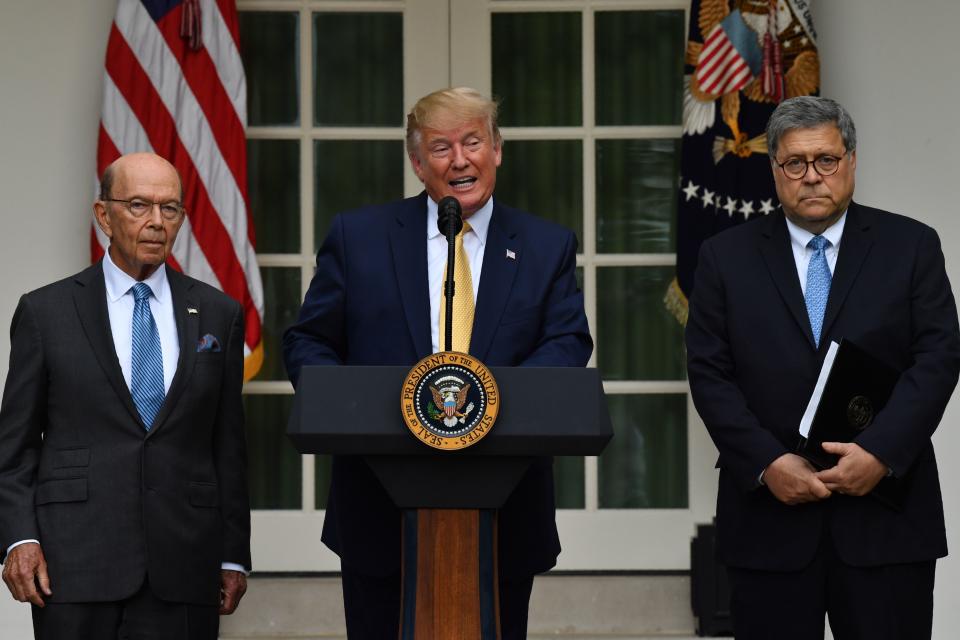Trump ends fight to include citizenship question on census and unveils new plan
President Trump officially dropped his controversial bid to add a citizenship question to the 2020 census on Thursday. Instead, he announced at a Rose Garden ceremony that he was issuing an executive order that instructs federal agencies to report data to the Commerce Department in order to better tabulate the number of U.S. citizens.
“Today I’m here to say we are not backing down on our effort to determine the citizenship status of the United States population,” Trump told his invited guests, many of whom attended a forum on social media immediately beforehand. “It is essential that we have a clear breakdown of the number of citizens and noncitizens that make up the U.S. population — imperative. Knowing this information is vital to formulating sound public policy, whether the issue is health care, education, civil rights or immigration.”
Supreme Court Chief Justice John Roberts wrote in June that the Trump administration’s stated reason for including the citizenship question in the census was “contrived,” temporarily blocking it from being included. Acknowledging that whatever new rationale his administration put forth to justify the addition of the citizenship question would face lengthy court fights, Trump detailed his plan B.
“Therefore, we are pursuing a new option to ensure a complete and timely count of the noncitizen population,” Trump said. “Today I will be issuing an executive order to put this very plan into effect immediately. I’m hereby ordering every department and agency in the federal government to provide the Department of Commerce with all requested records regarding the number of citizens and noncitizens in our country.”
Trump said the collected data would be used “to gain a full, complete and accurate count of the noncitizen populations, including databases maintained by the Department of Homeland Security and the Social Security Administration.”

“We have great knowledge in many of our agencies,” he added. “We will leave no stone unturned.”
By eliminating obstacles to data sharing, Trump said, the information would “ultimately allow us to have an even more complete count of citizens than through asking the single question alone.”
Commerce Secretary Wilbur Ross, who stood beside Trump and Attorney General William Barr in the Rose Garden, had contended that the citizenship question, which had been requested by the Trump administration, was necessary to help the Department of Justice enforce the Voting Rights Act of 1965, which protects against voting discrimination.
But several weeks before the Supreme Court decision to block the question, evidence was entered in a related case in New York, showing that the origins of the administration’s request were political. Documents disclosed that the proposal had been designed by a Republican consultant as a way to weight census results in favor of Republican-leaning neighborhoods.
Critics of the citizenship question believe that its inclusion could drastically reduce response rates in immigrant communities that could, in turn, result in fewer government services in minority communities and a higher representation of Republicans in Congress. In his remarks Thursday, Trump ignored those concerns.
“The Department of Commerce sensibly decided to include a citizenship question in the 2020 census as has been done many, many times throughout the history of the United States,” Trump said. “Unfortunately, this effort was delayed by meritless litigation,” he added, accusing “far-left Democrats” of “concealing the number of illegal aliens in our midst.”

A question about citizenship has been included on the census form before. The last time it was asked of every household was 1950. During the next census, in 1960, there was no mention of citizenship, just place of birth. In 1970, the Census Bureau created the first long-form questionnaire, which was sent to one in six households and included a citizenship question, although the short form, which continued to be sent to all households, did not ask about citizenship. In 2010, the long form was eliminated in favor of a yearly American Community Survey, while the short form is still sent out every 10 years, in adherence to the constitutional mandate.
Trump said the citizenship data, as collected by his executive order, would be “relevant to administering our elections,” as “some states may want to draw state and local legislative districts based upon the voter-eligible population.”
Barr, who earlier this week said there was still a pathway to adding the citizenship question to the census, conceded that “any new decision would be subject to immediate challenge” and jeopardize the ability to carry out the census in a timely matter.
“Turning to today, I applaud the president for recognizing in his executive order that including a question on the census is not the only way to obtain this vital information,” Barr said. “The course the president has chosen today will bring unprecedented resources to bear on determining how many citizens and noncitizens are in our country, and will yield the best data the government has had on citizenship in many decades.”
_____
Read more from Yahoo News:



